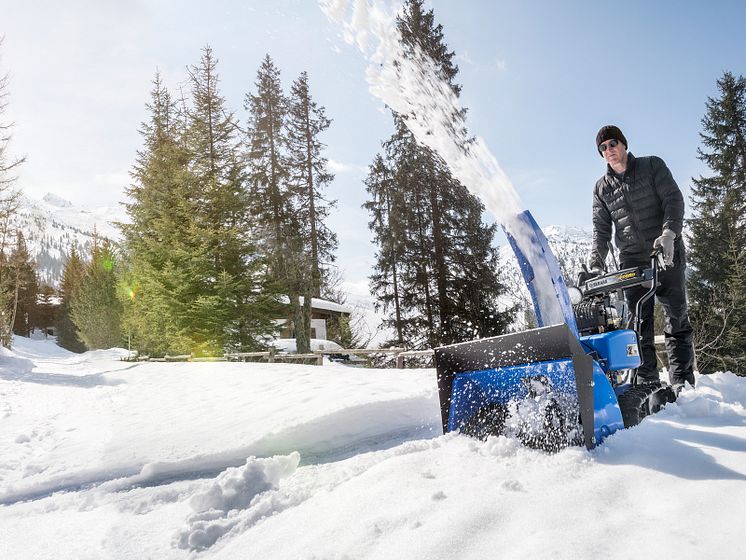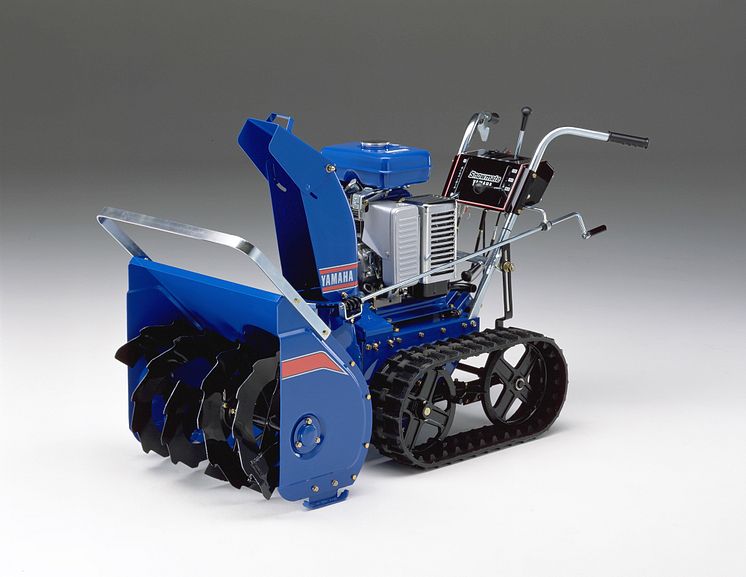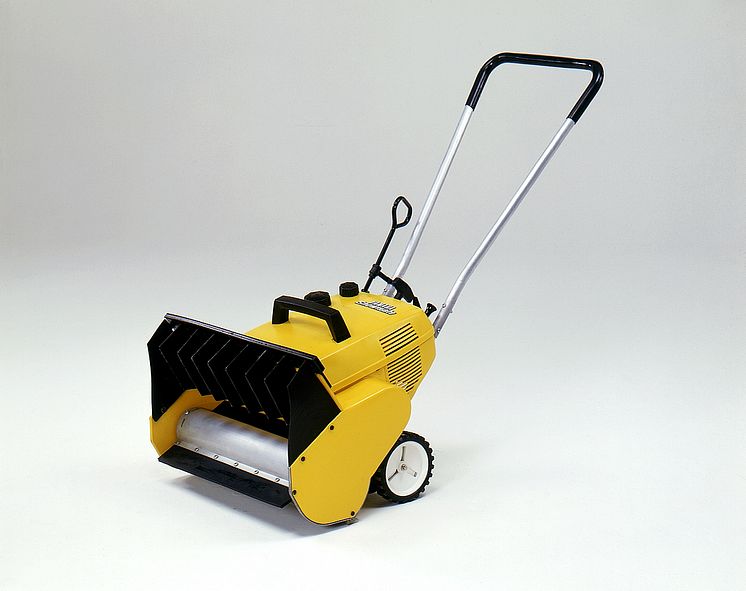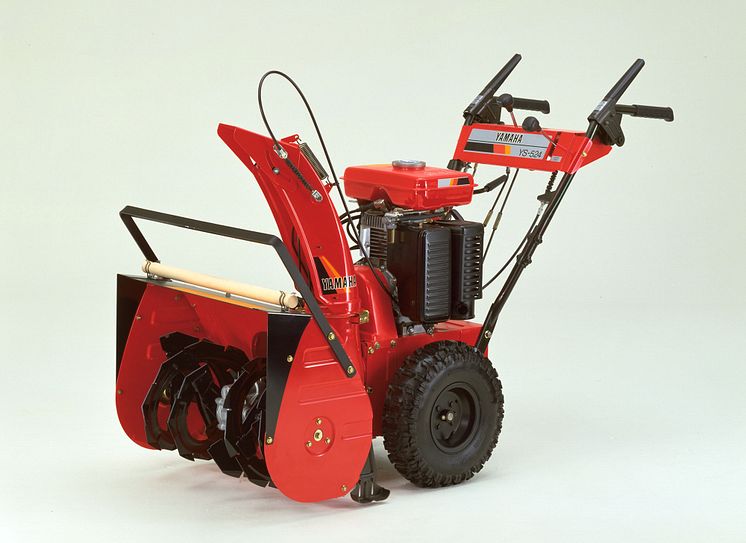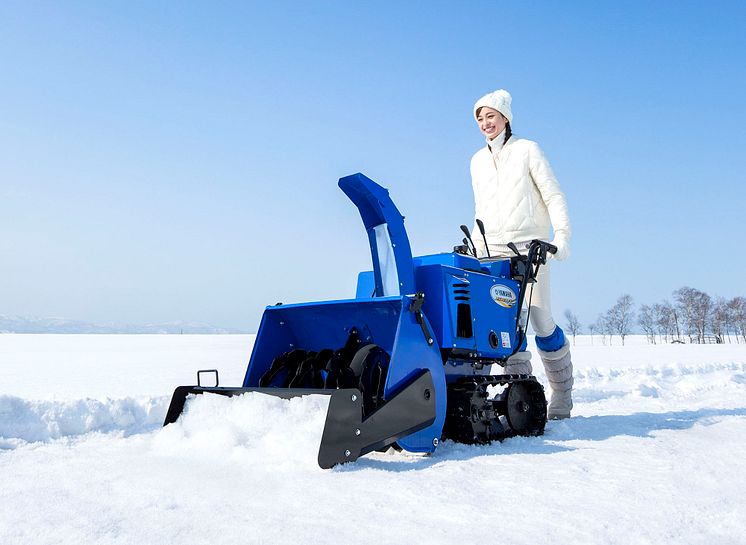
News -
Yamaha Snow Throwers -Making Life Easier and More Fulfilling for People in Snowy Regions Yamaha Motor Newsletter(Jan.15, 2018 No.61)
Yamaha Motor was founded in Japan as a motorcycle manufacturer in 1955. With the powertrain technology it garnered through motorcycle development and manufacture, the company steadily applied it towards diversifying its business, venturing into new product categories like outboard motors and snowmobiles. Like our racing karts and generators, snow throwers were also created using Yamaha’s multipurpose engines. Listening to the needs and requests of users in snow regions for more powerful, convenient and easier-to-use models for daily use, Yamaha refined and evolved its snow throwers to establish the solid track record and trusted reputation they have today. In the process, the market for Yamaha snow throwers went from Japan to North America, Europe and other snow regions, and new business possibilities are on the horizon. In this issue, we introduce our snow thrower business that celebrates its 40th anniversary in 2018.
World Demand: Some One Million Units Primarily in North America and Europe
For people living in snow regions, winter snowfall can be as troublesome as it is beautiful. A single night’s snowfall can often block the front door and bury roads, making transportation difficult and frequent snow removal a necessity. While large snow-throwing vehicles and snowplows often keep the main traffic arteries, large facilities and the like clear of snow, the inner walkways of these facilities, private homes and smaller facilities usually rely on individuals to remove the snow so that life can go on as usual.
If that means that everybody has to take snow shovels or pushers in hand to clear the snow and maybe use sleds or carts to pile it out of the way every day, just clearing the driveway, sidewalk, or road can amount to a heavy workload, especially for smaller women, children and the elderly. And if it has to be done early in the morning before going to work or school, making up for the time lost can alter a whole day’s schedule.
This is where the snow thrower can be just the thing people need. Small and mid-sized snow throwers for clearing snow around the home, sidewalks and roads, parking lots and the like have spread and grown in regions like North America, Europe and Japan, and global demand is said to be around one million units per year. These snow throwers can be largely divided into two types: simple and affordable single-stage models and more powerful, high-performance two-stage models.
A single-stage snow thrower has a structure similar to a small lawnmower, with an auger with several blades set in a drum in the front that spins to scoop in the snow and “throw” it out the chute in a given direction. The motor’s power is used only to turn the auger while the wheeled body of the machine is pushed manually by the operator. This is the most popular type of snow thrower in the world and they are usually used in areas with little snow accumulation or places that get dry, powdery snow.
The two-stage snow thrower has an auger that scoops up the snow and an impeller with revolving blades to throw the snow out in a two-stage action. The engine is used also to propel the machine, with some models using tracks to make it good on rough roads or surfaces, and other features to make them better suited for handling wetter, heavier snow and for areas with deeper snow accumulation.

Yamaha’s first snow thrower, the two-stage YT665
40th Anniversary: The History of Yamaha’s Blue Snow Throwers
Japan—where Yamaha Motor HQ is located—is a long and narrow archipelago that stretches northeast across from its continental Asian neighbors of Russia, China and South Korea beyond the Sea of Japan and the East China Sea. In winter, cold fronts come down from the continent, giving most areas of the country the chance see snow. In particular, the mountains near coastal areas along the Sea of Japan are hit by seasonal weather fronts that pick up moisture from the sea and then dump so much snow—mainly in Hokkaido and the Tohoku and Hokuriku regions—that wide swaths of land, where about 20 million people call home, are designated by the government as heavy snowfall areas.
In response to the needs of these parts of the country, Yamaha developed its first snowmobile in 1968 as part of its business diversification following its motorcycles and marine products, and then developed a snowmobile-towed snow-melting agent dispersion machine. To further answer demand in regions with snowfall, we began marketing snow throwers imported from the United States in 1974.
However, because of the wet, heavy type of snow that falls in Japan and the sheer amount of accumulation, home-use snow throwers from the U.S. couldn’t accommodate these conditions well and sales were poor. Yamaha realized that Japan would need a product that was meant for the environment and conditions of the Japanese winter, and we soon began developing our own snow thrower in-house with technical assistance from an agricultural equipment manufacturer that had know-how with snow-clearing equipment. And in 1978, we released our first two-stage Yamaha snow thrower powered by a 6 hp engine named the YT665, which had the capacity to clear 35 tons of snow per hour.
In the 40 years since then, Yamaha has continued to listen to the valuable input of our many customers and dealers while investing greater resources into technical development and accumulating proprietary snow thrower know-how. We reflected this feedback and the fruits of our R&D into creating numerous attractive products for customers.

The lightweight, compact and easy-to-use YSM250 was exported
to Canada and Europe in 1983 and sold as the YS220.
One example was the YSM250 released in 1980 that was designed for use at the average home expecting snow coverage between 25 and 50 m2. It featured a lightweight and compact 17 kg body that the user would push much like a baby carriage and used the first single-stage thrower mechanism in Japan.
It succeeded in offering the benefits of simple operation and quick engine start-ups while also being eco-friendly with low noise and vibration levels. Another example was the YSM555 released in 1982 designed to offer the base performance people wanted in a snow thrower to make clearing snow easier and quicker by enabling the user to pile the thrown snow where they wanted. Compared to the YT665, it had a lighter, more compact body, but the combination of its 5.5 hp engine and two-stage design gave it greater snow-throwing distance (up to 14 m) and the capacity to clear 32 tons of snow per hour.
After that, new features were added one after another to subsequent Yamaha models, including an electric starter to make starting easier, a lever-operated single-side clutch to make changing directions easier, a hydraulic assist tilt system for raising and lowering the auger housing, an electric-powered chute to easily change the direction of the thrown snow, and an auger housing rotation mechanism for clearing snow on slopes.
Entering the 2000s, development took on a new direction of “user-friendly high performance” targeting family use, particularly focused on making operation easier for women. These features included shear bolts to help prevent damage to the auger should a solid object be drawn in by its blades, a noise-reducing body design that encloses the engine, and a Jet Shooter feature with internal plates made of ultra-high molecular weight polyethylene plastic to help prevent snow clogging up the chute and ensure throwing ease. These became sales points that differentiated Yamaha snow throwers from the competition.
In recent years, Yamaha has introduced “two-in-one” snow thrower models for the Japanese market with a front-mounted plow to allow users to both plow away snow or perform standard two-stage snow-throwing. These models have won popularity in the market for their ability to deal with deep, light or melting snow conditions, allowing one machine to handle snowfall for the duration of a winter.

The “two-in-one” YS1070T-B released in 2017 comes fitted
with a plow in the front and is popular in Japan.
Growing the Market: The Steady March of Japanese Performance and Quality
Yamaha snow throwers were first exported overseas in 1983. The technical divisions at Yamaha headquarters developed models for overseas markets based on the YSM555, including the track-driven YS524T and wheel-driven YS524W, and exported them to Canada and Europe.

The wheel-driven YS524W could make very tight turns
and was painted red when exported to Europe and blue for Canada.
After that, the lineup of models being exported gradually grew and by the late 1980s, Yamaha was exporting nearly 9,000 units a year. However, from there a number of negative factors emerged and overlapped to cause an overall drop in demand, such as the price difference with local models, the increased value of the yen and climate change. This forced an unavoidable suspension of snow thrower exports for a time.
Still, “Our snow throwers that had won acclaim in Japan’s snow regions had also won strong approval overseas right from the beginning for being compact, easy to use and having excellent performance and durability,” says a Yamaha product planner who visited export markets as a service technician. “In eastern Canada in particular, the type and amount of snow that falls in a lot of places there is similar to heavy snowfall regions in Japan, so there were customers who specifically asked for Yamaha snow throwers, and not just homeowners but also clients who used them commercially for snow-clearing or at ski resorts.”
This led to the restart of exports around 2010 and we are currently working to recover demand with two-stage Yamaha snow throwers that have been consistently refined over the years in Japanese snow. “Besides some adjustments to fit local needs like handle height and safety standards, our export models are exactly the same spec as those sold in Japan. Although some say the levels of quality and performance are somewhat excessive, snow throwers are utility products that people in snow regions depend on in daily life, so we don’t change the specs just to be more competitive price-wise. We intend to build demand step by step by believing in the quality Yamaha can deliver and getting the customers to experience the value they offer.”
In this equation, the availability and quality of service provided by overseas distributors and dealerships in each country is another important factor. “We’ll listen to those hard at work in the field and what our customers have to say, and continue giving our support for parts supply and providing vital information,” concludes the product planner.
As we work to deliver exceptional value and experiences that enrich the lives of people in the world’s snow regions and fulfill our role as a Kando* Creating Company, we hope you will look forward to more great things from Yamaha in the future.
*Kando is a Japanese word for the simultaneous feelings of deep satisfaction and intense excitement that we experience when we encounter something of exceptional value.

|
Message from the Editor
The pure white world snow creates is not just a thing of beauty for those who live where it falls; it can also be a real pain to deal with.
Ever since its founding, Yamaha Motor has continued to grow while expanding its product offerings. Snow throwers are among our many product categories, but they are seldom seen in Yamaha’s home prefecture of Shizuoka due to its temperate climate. Still, they are a necessity for life in Japan’s many heavy snow regions.
The type of snow varies considerably by region, so Yamaha has continued to listen to its customers to supply compact snow throwers that provide the best possible solutions for their winter season problems. And when you see one in action effortlessly throwing an endless stream of white snow, it’s strangely satisfying to watch. Yamaha Motor will again continue its challenges this year to forge new paths through unknown fields, perhaps a bit like our snow throwers. Ryoko Ota |

